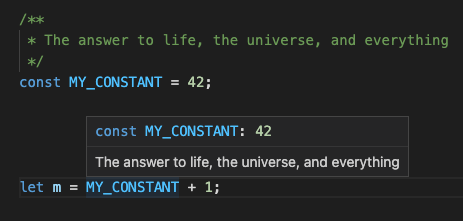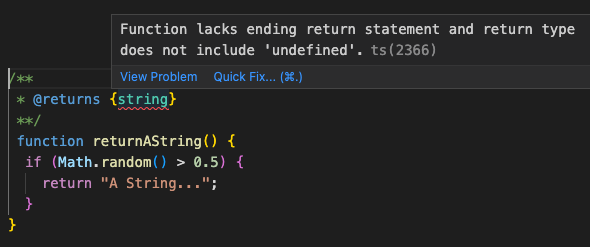A Pinch of Typescript in Javascript
Type-checking in Javascript: The Benefits and How to Implement it
I love Typescript and write a lot of it, but sometimes when I want to test an idea quickly scaffolding a Typescript project takes a little bit too long. In these cases, I prefer to work with my old friend, Javascript.
Recently, I was testing an idea for a browser extension, so I started coding with my old friend, Javascript, but as my code grew more complex I wanted some of that good old-fashioned type-safety™ to validate my assumptions; i.e., get my code to work.
So, I just added a pinch of Typescript, and I was good to go.

Wait a minute– A pinch of Typescript? In Javascript!? Let me explain.
Adding a Bit of Typescript to Javascript
First, you need to be using VS Code. VS Code has an internal Typescript server which is always available to check your code.
Second, you need a way to talk about types. const n: number = 555 isn’t valid javascript, so we’ll need another way to describe types. For this we can use JSDoc: a way of annotating Javascript code inside of comments.
Finally, you need to connect these two together.
Connecting the dots
There are two ways to tell VS Code’s server to Look Alive!
We can check individual files by adding a // @ts-check comment at the top of the file. This will tell the server to check the file for errors.
// @ts-check
// ... your code hereWe can also check the entire project by adding a jsconfig.json file to the root of the project. This will tell the server to check all files in the project for errors.
{
"compilerOptions": {
"checkJs": true
}
}Now we’re ready to start adding types to our Javascript code 🎉
My Go-To Uses
For me, checking types in JavaScript is about having just enough types to validate assumptions, while still keeping my setup loosey-goosey.
With that said, here are the ways I use this most often:
Comments To-Go
This may seem weird, using JSDoc just for commenting is great because comments follow the variable or function they describe.
If I forget why I needed this variable or function tomorrow, now all I need to do is hover and I’ll get a reminder.
This works great for functions/variables that are used in multiple places.

Typing Arguments
Better safe than sorry!
/**
* @param {string} name
* @param {number} age
**/
function sayHello(name, age) {
console.log(`Hello, ${name}! You are ${age} years old.`);
}Typing Function Return Values
Ok, I’ll admit it: Typescript catches edge cases that I would never think of.
/**
* @returns {number}
**/
function returnANumberPlease(a, b) {
return a + b;
}
Type Assertions
Sometimes you just want to explain what type a variable will store.
/** @type {number[]} **/
let myNumberArr = [];
Sharing Types Across Files
Imagine you have a type with several properties that you want to use in multiple files. I find the way of defining types in JSDoc to be a bit verbose, so I prefer to define types in a separate file and import them.
// types.ts
export type Person = {
name: string;
age: number;
};
export type Actor = Person & {
job: "actor";
movies: string[];
};Now, back in javascript-land I can do this:
// @ts-check
/** @type {import("./types").Actor} */
let johnCusack = {
name: "John Cusack",
age: 53,
job: "actor",
movies: ["High Fidelity", "Say Anything", "Grosse Pointe Blank"],
};Type Guards
If you’re not familiar with it, a type guard is a way to tell Typescript that you know what type a variable is if something about it is true.
Taking our types from above, imagine we want to express that a type is an Actor if it has a job property equal to "actor".
/**
* @param {Person | Actor} person
* @returns {person is Actor}
*/
function isActor(person) {
return "job" in person && person.job === "actor";
}Now we can use that function elsewhere to tell Typescript that we know the variable in question is of the Actor type.
Conclusion
In practice, Typescript and Javascript don’t have to be completely separate worlds; instead, there’s a spectrum between them.
Hopefully this article will help you move between the two more easily– giving you more choices and confidence next time you sit down to code something. Thanks for reading!
Let me know how you use Typescript in Javascript on Twitter @tone_row_